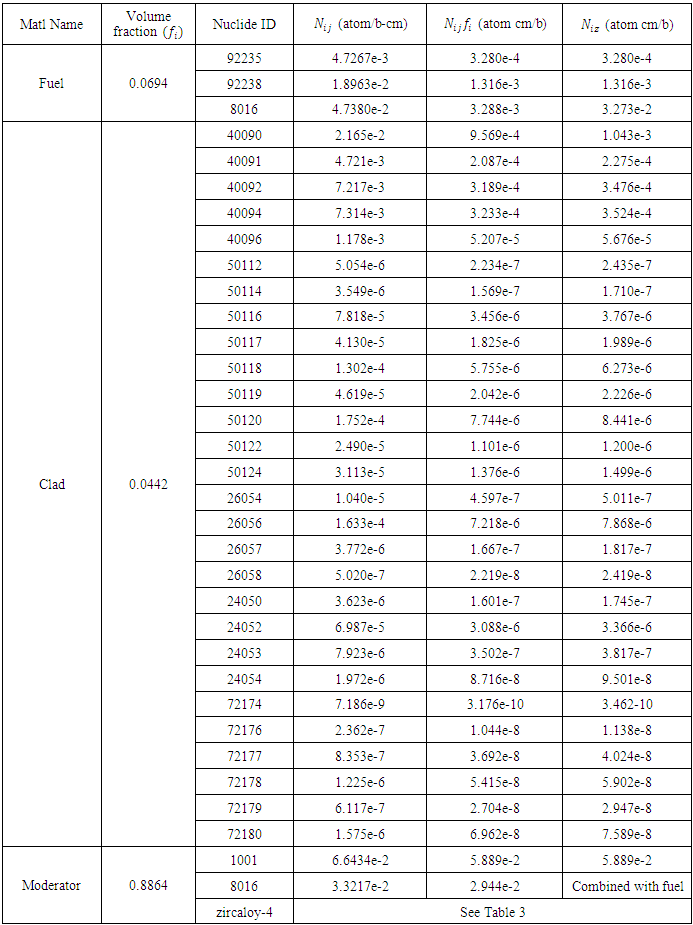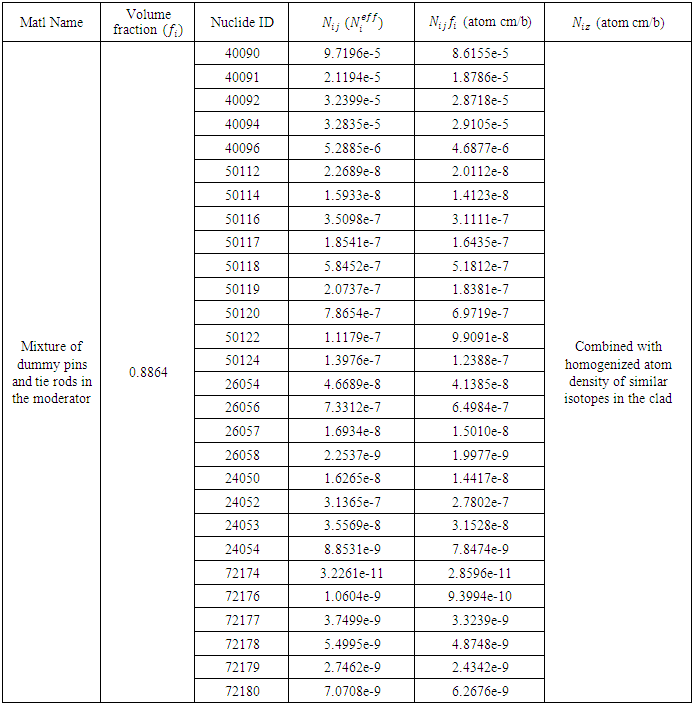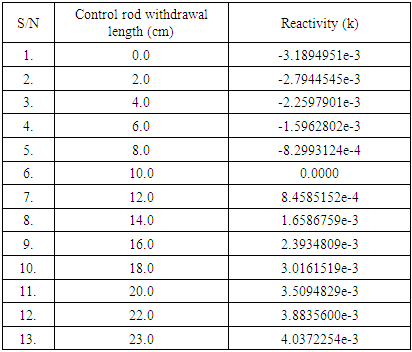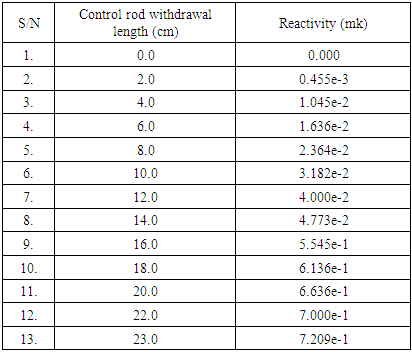-
Paper Information
- Paper Submission
-
Journal Information
- About This Journal
- Editorial Board
- Current Issue
- Archive
- Author Guidelines
- Contact Us
Journal of Nuclear and Particle Physics
p-ISSN: 2167-6895 e-ISSN: 2167-6909
2017; 7(2): 27-35
doi:10.5923/j.jnpp.20170702.02

Consummation of 19.75% UO2 Fuel Material in the Core of Nigeria Miniature Neutron Source Reactor (MNSR)
Samson D. O., Buba A. D. A.
Department of Physics, University of Abuja, Abuja, Nigeria
Correspondence to: Samson D. O., Department of Physics, University of Abuja, Abuja, Nigeria.
| Email: |  |
Copyright © 2017 Scientific & Academic Publishing. All Rights Reserved.
This work is licensed under the Creative Commons Attribution International License (CC BY).
http://creativecommons.org/licenses/by/4.0/

Investigation has been done concerning the performance of 19.75% uranium dioxide (UO2) fuel material in the core of the Nigeria Research Reactor-1 (NIRR-1), a Miniature Neutron Source Reactors (MNSRs) manufactured by China Institute of Atomic Energy (CIAE) using SCALE 6.1 and VENTURE-PC codes. This is in line with the current efforts to convert the core of NIRR-1 from Highly Enriched Uranium (HEU) core (90.2% enriched UAl4-Al fuel) to Low Enriched Uranium (LEU) core (19.75% enriched UO2-zircaloy-4 fuel). The geometry and dimensions of HEU and LEU cores were exactly the same except the increase in the fuel cell diameters from 1.2384cm to 1.632cm. Results obtained shows that the total control rod worth of 7.23mk (723pcm), clean cold core excess reactivity of 4.04mk (404pcm),  of 1.0119634, shutdown margin of 3.19mk (319pcm) and neutron flux profile of
of 1.0119634, shutdown margin of 3.19mk (319pcm) and neutron flux profile of  with stability of
with stability of  vertical and horizontal variation less than three percent
vertical and horizontal variation less than three percent  for the proposed LEU core are a bit more than that of the present HEU core. The model predictions of this parameters for NIRR-1 system in this study are perfectly in agreement with experimental results as well as the results from similar computations using different nuclear tools.
for the proposed LEU core are a bit more than that of the present HEU core. The model predictions of this parameters for NIRR-1 system in this study are perfectly in agreement with experimental results as well as the results from similar computations using different nuclear tools.
Keywords: MNSR, NIRR-1, LEU, HEU, SCALE 6.1 code, VENTURE-PC code, Neutronics, Control rod worth, Excess reactivity, K-effective, Shutdown margin, Uranium dioxide
Cite this paper: Samson D. O., Buba A. D. A., Consummation of 19.75% UO2 Fuel Material in the Core of Nigeria Miniature Neutron Source Reactor (MNSR), Journal of Nuclear and Particle Physics, Vol. 7 No. 2, 2017, pp. 27-35. doi: 10.5923/j.jnpp.20170702.02.
Article Outline
1. Introduction
- Despite the availability of numerous type of nuclear fuel materials that can be used in reactor systems, majority of commercial reactors in the world are using uranium dioxide (UO2) as fuel, the most common ceramic fuel (Sunghwan, 2013). Some of the benefits of using UO2 as reactors fuel include: strong non-proliferation characteristics, chemical inertness, compatibility with potential cladding materials such as stainless steel and zircaloy, dimensional stability under irradiation, very high melting point and excellent resistance to corrosion when exposed to high temperature and pressure (Lyons et al., 1972; Sunghwan, 2013). The Nigeria Research Reactor-1 (NIRR-1) is one of the few reactors in the world with a core that requires conversion from HEU to LEU fuel. A number of feasibility studies have been carried out for this reactor to investigate the possibility of using 12.5% UO2 material to convert the core from HEU to LEU fuel (Jonah et al., 2009; Salawu, 2012; Jonah et al., 2012; Ibrahim et al., 2013). The results from these types of studies using various nuclear analysis tools such as MCNP, CITATION and VENTURE-PC (Jonah et al., 2007; Balogun, 2003; Salawu, 2012), has shown that there will be a slight reduction in the thermal neutron flux in the core of NIRR-1 when fuel with 12.5% UO2 material. In addition, these studies have also revealed that the hydrogen to uranium ratio will decrease to about ten percent (10%) in the proposed LEU core (Salawu, 2012). This could be the possible cause of the observed reduction in the thermal neutron flux of NIRR-1 as the core is left with less number of hydrogen to thermalize the neutron. Our major interest in this work is to find a means of increasing the hydrogen content in the core by replacing 12.5% UO2 material in the proposed LEU core with 19.75% UO2 material plus a corresponding decrease in the number of fuel pins in the core. This will give room for more moderators in the core and could increase the number of hydrogen available to thermalize the neutron in the potential LEU core for Nigeria Research Reactor-1 (NIRR-1). Hence the hydrogen to uranium ratio will increase with a corresponding increase in the thermal neutron flux. The current HEU NIRR-1 core has a tank-in-pool structural configuration, a nominal thermal power rating of 31.1kW, 230 x 230mm square cylinder, fueled by U-Al4 enriched to 90.2% and was originally designed by China with a diffusion theory codes (HAMMER and EXTERMINATOR-2) (CERT, 2004; Jonah et al., 2005). It is in Al-alloy cladding whose thickness is 0.6mm. Light water is used as moderator and coolant while metallic beryllium is used as reflector. It has a total number of 347 fuel pins, three Al dummy pins and four tie rods. The length of the fuel element is 248mm; the active length being 230mm with 9mm Al-alloy plug at each end. The diameter of the fuel meat is 4.3mm, fuel meat volume density is 3.456g/cm3 and the U-235 loading in each fuel element is about 2.88g. The control rod is made up of a cadmium (Cd) absorber of 266mm long and 3.9mm in diameter with stainless steel of 0.5mm thickness as the cladding material and overall length of 0.450m (Figures 1 and 2). With a built-in clean cold core excess reactivity of 3.77mk (377pcm) measured during the on-site zero-power and criticality experiments, the reactor can operate for a maximum of 4 hours 30 minute at full power, mainly due to the large negative temperature feedback effects (FSAR, 2005; Jonah et al., 2006). These design computations (such as neutron multiplication factors, neutron fluxes, fuel burn-up, fuel cycle length, isotopic inventory, cross section libraries etc.) was repeated in Nigeria with WIMS/CITATION and MCNP (Balogun, 2003). A recent version of the diffusion theory code called VENTURE-PC were used in this work to perform the neutronics analysis with a recent version of SCALE (SCALE 6.1) code system to generate a cross section library for the proposed LEU core for NIRR-1 (Butler and Albright, 2007; SCALE, 2011; Salawu, 2012). A licensed user of the codes performed the actual calculations and generated the output data used to perform this analysis. In this work the effective multiplication factor for the system, excess reactivity, reactivity worth of the control material, shim worth and power distribution at different locations within the Nigeria Research Reactor-1 (NIRR-1) core were determined. In addition the relative flux levels at different location within the system were calculated. These locations include the inner and outer irradiation sites in the core of NIRR-1 system using 19.75% UO2 material as the fuel. Achieving the core conversion of NIRR-1 to operate on the LEU fuel would be a helpful step forward in this international effort to reduce and eventually eliminate the civil use of HEU material in research reactors.
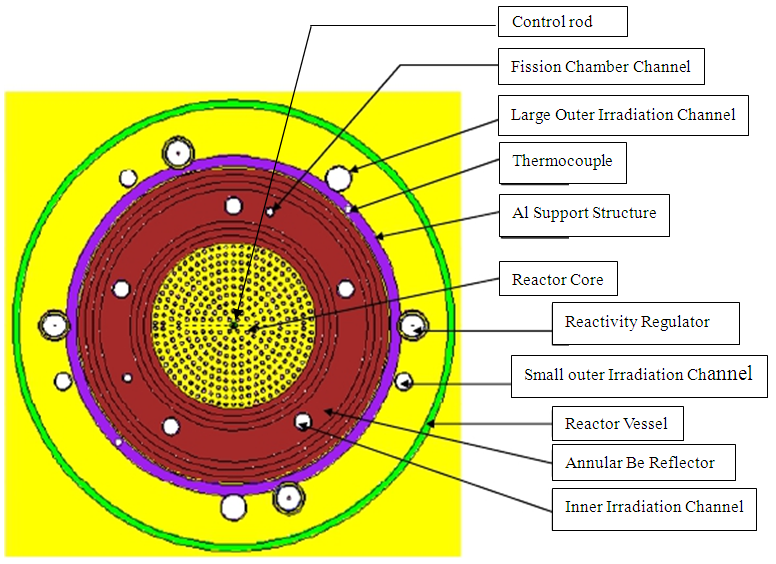 | Figure 1. Front View of NIRR-1 core configuration |
 | Figure 2. A close Side View of NIRR-1 core configuration |
2. Materials and Methods
- VENTURE-PC code has be used primarily in this work to compute group fluxes profiles and criticality information within the Nigeria Research Reactor-1 core region, while SCALE 6.1 serves as a mean to generate the N-group cross section libraries, perform the neutron flux calculations, as well as provide k-infinity from the criticality calculation for the proposed 19.75% enriched UO2 material for core conversion studies of NIRR-1 core. The N-group cross section library used were copied from the SCALE run output file and stored in three different WordPad files. Uranium dioxide (19.75% UO2) fuel of volume density 10.6g/cm3 is the potential LEU fuel material chosen to perform this core conversion study for NIRR-1 with zircaloy-4 as the cladding material. Zircaloy-4 has a density of 6.56g/cm3 with a natural zirconium of 98.23 weight percent (w/o) (Salawu, 2012; Samson, 2015). The geometry and dimensions of the proposed LEU fuel material will be invariant in some aspect but the fuel cell radius will vary from that of the present NIRR-1 fuel material, which will leads to a decrease in the number of active fuel pins to about 200. The three aluminium dummy pins and four aluminium tie rods in the HEU core were replaced by zircaloy-4 material of the same dimensions. The active fuel length, active fuel diameter and fuel cell diameter are 23.0cm, 0.43cm and 1.632cm respectively. The uranium in the active fuel region of the LEU fuel material is enriched to 19.75% U-235 with each fuel rod containing 6.162g of U-235. The volume fraction
 for the zones in the fuel cell is determined by first calculating the volume of each zones and then divide each values obtained by the total volume of the equivalent fuel cell.
for the zones in the fuel cell is determined by first calculating the volume of each zones and then divide each values obtained by the total volume of the equivalent fuel cell.  | (1) |
 | (2) |
 is done by multiplying the region atom density
is done by multiplying the region atom density  by the region volume fraction
by the region volume fraction  for the zones in the NIRR-1 fuel cell (Equations 3 and 4).
for the zones in the NIRR-1 fuel cell (Equations 3 and 4).  | (3) |
 | (4) |
 is the atom density of isotope i in region j,
is the atom density of isotope i in region j,  is the volume fraction of region j in zone z,
is the volume fraction of region j in zone z,  is the volume of region j and
is the volume of region j and  is the composite volume of all the regions within the zone of interest. The effective density
is the composite volume of all the regions within the zone of interest. The effective density  of the nuclides in the moderator region and that of the mixture of the four aluminium tie rods and three dummy pins of the LEU fuel cell model were obtained by multiplying the region atom density
of the nuclides in the moderator region and that of the mixture of the four aluminium tie rods and three dummy pins of the LEU fuel cell model were obtained by multiplying the region atom density  by the volume fraction
by the volume fraction  obtained from the 200 active fuel rods of LEU fuel materials in the core of NIRR-1. The results of the calculated average homogenized atom density
obtained from the 200 active fuel rods of LEU fuel materials in the core of NIRR-1. The results of the calculated average homogenized atom density  for the LEU fuel material for NIRR-1 core is shown in Table 1, the results of the atom densities of various isotopes in zircaloy-4 were tabulated in Table 2, while the average homogenized atom density in the water mix region for the zircaloy-4 were illustrated in Table 3.
for the LEU fuel material for NIRR-1 core is shown in Table 1, the results of the atom densities of various isotopes in zircaloy-4 were tabulated in Table 2, while the average homogenized atom density in the water mix region for the zircaloy-4 were illustrated in Table 3.
|
|
|
 at different depth of insertion of control rod. These data were then used to calculate the reactivity worth of the control rod as shown in Table 4 for the LEU NIRR-1 core model, while the corresponding HEU core were tabulated in Table 5.
at different depth of insertion of control rod. These data were then used to calculate the reactivity worth of the control rod as shown in Table 4 for the LEU NIRR-1 core model, while the corresponding HEU core were tabulated in Table 5.
|
|
3. Results and Discussion
- The geometry and dimensions of various components in the proposed LEU core for NIRR-1 were kept identical with that of the present HEU core of the system. This is to ensure that the thermal-hydraulics characteristic of NIRR-1 system remains unaltered. The front and side view of NIRR-1 core configuration is illustrated in Figures (1 and 2). A plot of the variation in k-infinity as a function of hydrogen to uranium ratio is shown in Figure 3, while that of reactivity as a function of control rod withdrawal distance for the proposed 19.75% LEU core for the system is shown in Figure 4. The method used involve no apparent spatial dependence of cross sections in the active fuel region because they were treated as constant in the homogeneous regions, but in the actual system of NIRR-1, there is a spatial dependence of cross sections in the active fuel region because each fuel pin is surrounded with clad and water and there are several configurations of fuel/clad/water within the NIRR-1 core. The results generated for the total number of hydrogen atoms in each of the fuel cell radii is shown in Table 6, while the data generated for k-infinity as a function of hydrogen to uranium (H/U) is shown in Table 7. A Matlab programming language was used to plot this data as shown in Figure 3 (Gerald, 2001; Matlab R2013b).
|
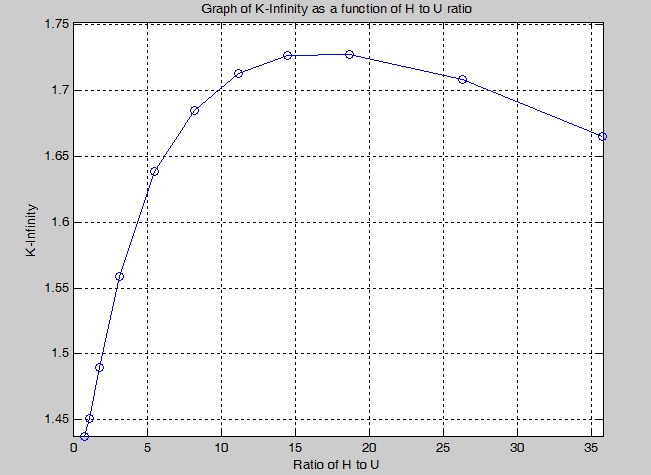 | Figure 3. Plot of k-infinity as a function of H to U ratio for the LEU (19.75% UO2) core |
|
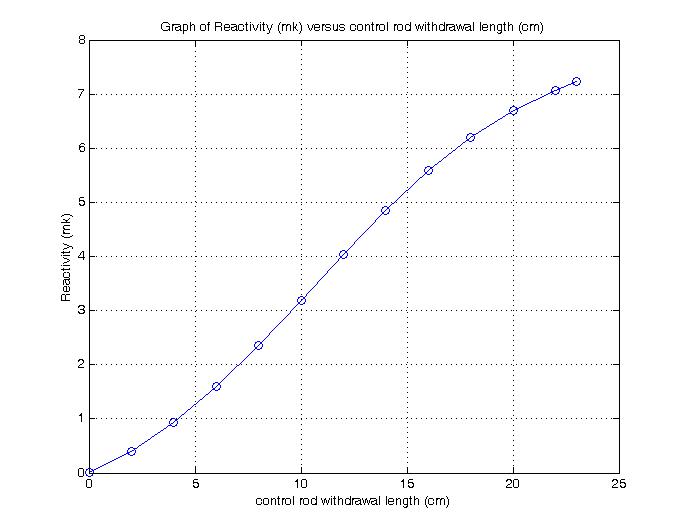 | Figure 4. Reactivity (mk) versus control rod withdrawal length (cm) of active LEU (19.75% UO2) fuel region |
 at different level of control rod withdrawal length were used to compute the reactivity worth of the control rod (see Table 3). This was used to produce the graph of reactivity versus control rod withdrawal length for the proposed 19.75% LEU core for NIRR-1 (Figure 3).The clean cold core excess reactivity calculated for the 19.75% LEU core for NIRR-1 was
at different level of control rod withdrawal length were used to compute the reactivity worth of the control rod (see Table 3). This was used to produce the graph of reactivity versus control rod withdrawal length for the proposed 19.75% LEU core for NIRR-1 (Figure 3).The clean cold core excess reactivity calculated for the 19.75% LEU core for NIRR-1 was  the shutdown margin was
the shutdown margin was  and the corresponding value of
and the corresponding value of  was
was  for the proposed LEU (UO2) fuel. These values are in good agreement with the design specification of 3.5mk – 4.0mk for MNSR as reported by (Chengzen, 1993) and HEU (UAl4) of 4.0mk value reported by (Balogun, 2003) using CITATION code and 4.7mk by (Jonah et al., 2009) using MCNP5 code version 1.40, shutdown margin of 2.87mk by (Jonah et al., 2009) using MCNP code and 2.18mk by (Azande et al., 2011) using a simplified scheme of WIMS and CITATION codes,
for the proposed LEU (UO2) fuel. These values are in good agreement with the design specification of 3.5mk – 4.0mk for MNSR as reported by (Chengzen, 1993) and HEU (UAl4) of 4.0mk value reported by (Balogun, 2003) using CITATION code and 4.7mk by (Jonah et al., 2009) using MCNP5 code version 1.40, shutdown margin of 2.87mk by (Jonah et al., 2009) using MCNP code and 2.18mk by (Azande et al., 2011) using a simplified scheme of WIMS and CITATION codes,  value of
value of  by (Jonah et al., 2009; Ibrahim et al., 2013) using MCNP code. The slight difference between the measured and computed clean cold core excess reactivity shows that during measurements the shim plates were stacked over each other and submerged in water. There is always a thin film of water remaining between the adjacent shim plates. During calculation no water was taken into account while modelling the beryllium shim plates in the shim tray. As a result of this the measured reactivity for the HEU core is higher than the computed reactivity for the proposed LEU core. The shutdown margin for the LEU (UO2) is large in comparison with the recommended safety limit
by (Jonah et al., 2009; Ibrahim et al., 2013) using MCNP code. The slight difference between the measured and computed clean cold core excess reactivity shows that during measurements the shim plates were stacked over each other and submerged in water. There is always a thin film of water remaining between the adjacent shim plates. During calculation no water was taken into account while modelling the beryllium shim plates in the shim tray. As a result of this the measured reactivity for the HEU core is higher than the computed reactivity for the proposed LEU core. The shutdown margin for the LEU (UO2) is large in comparison with the recommended safety limit  The
The  value obtained show that the potential LEU (UO2) core is said to be critical since for fission chain reaction to be just continuing at a steady state;
value obtained show that the potential LEU (UO2) core is said to be critical since for fission chain reaction to be just continuing at a steady state;  has to be approximately unity. Expectations are that when the control rod is fully withdrawn, the super-criticality should be attained while sub-criticality should be attained when the control rod is fully inserted. It is therefore, desirable that criticality should be attained about midway between full withdrawal and full insertion of the control rod so as to allow for easy control and regulation of reactivity (see Table 4). The thermal neutrons flux level calculated in the 19.75% LEU core for NIRR-1 was
has to be approximately unity. Expectations are that when the control rod is fully withdrawn, the super-criticality should be attained while sub-criticality should be attained when the control rod is fully inserted. It is therefore, desirable that criticality should be attained about midway between full withdrawal and full insertion of the control rod so as to allow for easy control and regulation of reactivity (see Table 4). The thermal neutrons flux level calculated in the 19.75% LEU core for NIRR-1 was  with stability of
with stability of  , vertical and horizontal variation less than three percent
, vertical and horizontal variation less than three percent  This value is in good agreement with the nominal value of
This value is in good agreement with the nominal value of  stability of
stability of  vertical and horizontal variation
vertical and horizontal variation  for the present HEU core of NIRR-1.The thermal neutron flux in the 12.5% UO2 core from similar calculation was observed to be slightly lower than the thermal neutron flux in the HEU core due to hardening of the neutron spectrum. This implies that the total number of neutrons that were able to get to the thermal energy in the thermalization processes is slightly higher in the 19.75% UO2 core with 200 active fuel pins than in the 12.5% UO2 core with 347 pins.
for the present HEU core of NIRR-1.The thermal neutron flux in the 12.5% UO2 core from similar calculation was observed to be slightly lower than the thermal neutron flux in the HEU core due to hardening of the neutron spectrum. This implies that the total number of neutrons that were able to get to the thermal energy in the thermalization processes is slightly higher in the 19.75% UO2 core with 200 active fuel pins than in the 12.5% UO2 core with 347 pins.4. Conclusions
- Comparison of the results obtained from the neutronics calculation using the VENTURE-PC computer code in this work clearly shows that the model is accurate for conducting neutronics analysis for NIRR-1 and useful in the core conversions of Miniature Neutron Source Reactors (MNSRs) to LEU. The proposed 19.75% LEU core is very reactive relative to the core of the HEU system. Therefore the number of regulatory rod in the current HEU core might not be sufficient to reduce the reactivity of the system to a critical level. The results from the calculation performed in this work has shown that 19.75% UO2 material can also be considered for a more detail analysis for the core conversion studies of NIRR-1 from HEU to LEU. The results of the reactor parameters generated in this work were as expected and the model developed in this work will be of great important in the development of computational models for future analytical studies of the proposed LEU-fuelled NIRR-1 core.
ACKNOWLEDGEMENTS
- The authors wish to appreciate the staff of Physics department, Nigeria Defence Academy, Kaduna, Nigeria for their assistance during the course of this research work.
 Abstract
Abstract Reference
Reference Full-Text PDF
Full-Text PDF Full-text HTML
Full-text HTML